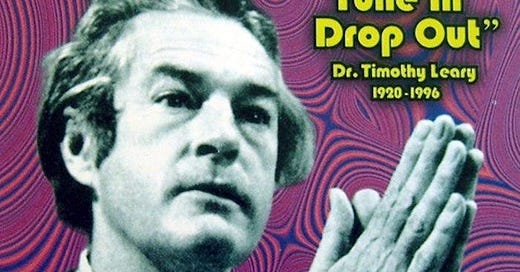At a 2024 gathering of the National Association of Black Journalists, Trump warned about the threat of immigrant labor: “Coming from the border are millions and millions of people who happen to be taking Black jobs.” The clumsy wording quickly became a meme, but Trump’s meaning is clear in context: “They're taking the employment from Black people.” Black jobs, in other words, are reserved for Blacks.
Some leaders amplify fears of job loss—of ‘being replaced’ by foreigners or by artificial intelligence. The essence of MAGA is a nostalgic response to these fears of change: We should return to earlier decades, when jobs were guaranteed, just because of who you were. Yet another leader archetype is the visionary: he imagines a future that doesn’t yet exist and wills it into being. If he succeeds, we remember his name.
One such man was key to these words reaching your eyes today. Steve Jobs saw a vision of a personal computing device in every home and of ‘1,000 songs in your pocket.’ He probably didn’t envision ‘iPad kids,’ but Jobs touched the butterfly that created them. At the time of his death in 2011, Apple—the team of ‘A players’ he started in his parents’ garage—had become the world’s most valuable company.
Million-Dollar Anchor Baby
Steve Jobs was likely conceived in Homs, though he was born in the US.1 Joanne Schieble met Abdulfattah Jandali while she was a graduate student at the University of Wisconsin, and he was a teaching assistant. They fell in love, and spent months in Syria with his family, but Joanne’s father threatened to disown her if she married Abdulfattah. In 1955, she went to San Francisco to give birth and arrange an adoption.
Steve was adopted by Paul Jobs, a repo man, and Clara, an accountant. Growing up in Mountain View, California, he was often bored by his teachers and frequently pranked them. At 16, he met Steve Wozniak—an alumnus of their high school—and the two bonded over Bob Dylan and phreaking. Later, at Reed College, Jobs deepened his pursuit of enlightenment through vegetarianism, Zen Buddhism, and LSD.
By the early 1970s, the hippie counterculture had flipped from seeing the computer as a tool of bureaucratic control to regarding it as a symbol of individual expression. Jobs and Woz joined the Homebrew Computer Club in Menlo Park, where hobbyists swapped schematics for free.2 Jobs bristled at the club’s anti-commercial culture and persuaded Woz to start their own company. They called it ‘Apple Computer.’
Jobs preached that the Macintosh would be so easy to use that it wouldn’t even need a manual. Apple’s designs avoided imitating the military greens and grays of competing machines; instead, Jobs drew inspiration from Braun kitchen appliances, BMW motorcycles, and Bösendorfer pianos. Its marketing campaigns celebrated nonconformity, from the ‘1984’ Super Bowl ad to the ‘Think Different’ series.
The Zen of Profit: Apple Goes Global
Steve Jobs’ attitude toward money was complex. Coming from modest means, he never fully blended with the nouveau riche. He disliked the conspicuous consumption of Apple employees who bought Rolls-Royces and gave their wives plastic surgeries. That skepticism extended to the 1990s ‘venture philanthropy’ fad, which was like a data-driven precursor to today’s Effective Altruism, minus the moral philosophy.
But from a young age, Jobs loved negotiating and turning a profit. As a child, he’d haggle for electronic parts at the flea market, then flip them for profit at the electronics store where he worked weekends. By the turn of the century, Apple’s biggest challenge was building just-in-time factories and supply chains, which were only available at scale in East Asia. To stay profitable, Apple had to go global.
Apple’s relationship with its Asian suppliers was more shrewd than generous. In 2001, on a routine trip to Japan, Apple’s head of hardware, Jon Rubinstein, discovered a tiny 1.8-inch drive Toshiba was developing—a palm-sized device with 5GB of storage (enough for about a thousand songs). Toshiba’s team wasn’t sure how to use it, but Rubinstein was: he negotiated exclusive rights to the hardware, and the iPod was born.
Over time, Apple refined this knack for forging strategic hardware deals—whether by spotting Toshiba’s miniature drive first or by later subsidizing partners’ R&D and leveraging its massive market share. From priority LG screens to custom chips from TSMC, Apple reaped performance and efficiency gains at cost, plowing profits back into product innovations. There was just one catch: politics and the growing ‘techlash.’
If Abdulfattah Jandali Stays Home
A 2011 dinner between Obama and Silicon Valley executives was full of mutual frustration. Jobs boasted of innovation, while Obama focused on one number: how many Americans did Apple employ? General Motors employed over 400,000 Americans in the 1950s, while Apple employed only 43,000. Most of the 700,000 jobs in Apple’s supply chain contractors—like Foxconn, which assembled iPhones—were in Asia.
Jobs’ reply foreshadowed the infamous Ramaswamy tweet: the US should outcompete rivals by training more engineers, maybe even ‘staple green cards to diplomas.’ But Obama insisted he couldn’t divorce high-skilled tech visas from the plight of the ‘DREAMers.’ Crying Mexican schoolgirls, in other words, held more sway in the Obama coalition than Silicon Valley executives. Theatre kids were in control.
Many Hispanics have since defected to the Trump coalition, but when it comes to tech, the threat—whether to ‘black jobs’ or ‘American jobs’—is still Asian. During the H1-B visa debate, Steve Bannon told The Free Press: “American jobs should be for American citizens,” and added that tech hiring should reach at least 20% African American and 20% Hispanic employees before any further immigration is allowed.
If these quotas actually took hold, they could drive top talent out of the United States, just as reservations have done in India. For policymakers with racist or nationalist worldviews, that might be exactly what they want. The real tragedy is the world we never get to see: the thwarted collaborations that spark the next personal computer revolution. Or maybe that revolution still happens—just not in America.
Unless otherwise noted, all information is drawn from Walter Isaacson’s biography.
Another famous defector from the Homebrew Computer Club’s ethos was Bill Gates.






I had no clue that Obama was hocking this kind of populist anti-immigrant attitude to tech bros. If that's the treatment they got from Democrats, it helps explain why they are trying their hand now with the Republicans.